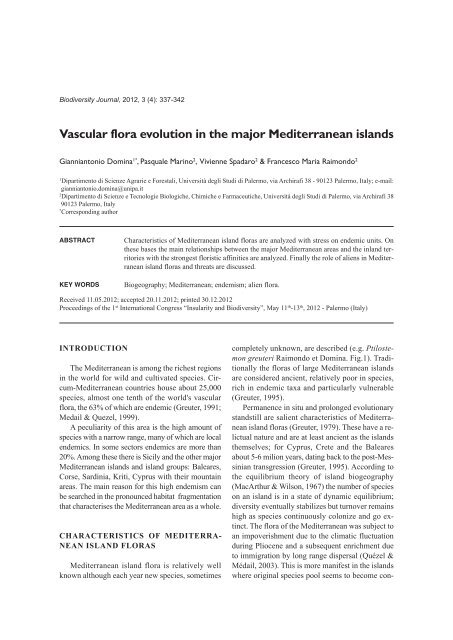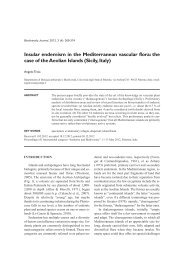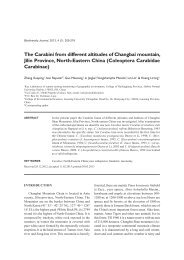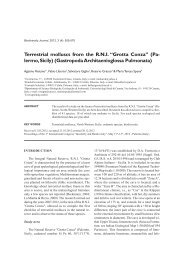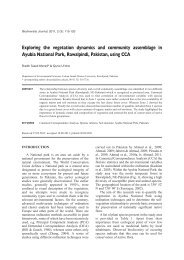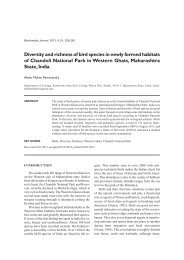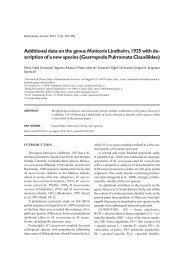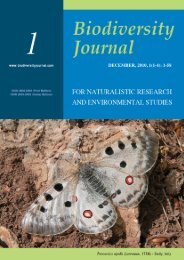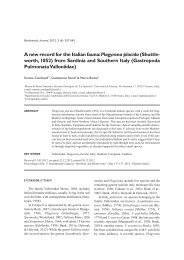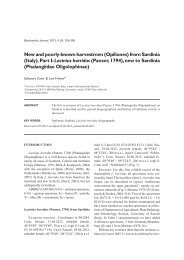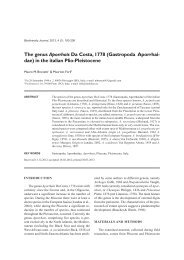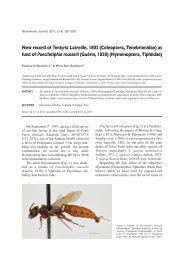Vascular flora evolution in the major Mediterranean islands
Vascular flora evolution in the major Mediterranean islands
Vascular flora evolution in the major Mediterranean islands
You also want an ePaper? Increase the reach of your titles
YUMPU automatically turns print PDFs into web optimized ePapers that Google loves.
Biodiversity Journal, 2012, 3 (4): 337-342<strong>Vascular</strong> <strong>flora</strong> <strong>evolution</strong> <strong>in</strong> <strong>the</strong> <strong>major</strong> <strong>Mediterranean</strong> <strong>islands</strong>Gianniantonio Dom<strong>in</strong>a 1* , Pasquale Mar<strong>in</strong>o 2 , Vivienne Spadaro 2 & Francesco Maria Raimondo 21Dipartimento di Scienze Agrarie e Forestali, Università degli Studi di Palermo, via Archirafi 38 - 90123 Palermo, Italy; e-mail:gianniantonio.dom<strong>in</strong>a@unipa.it2Dipartimento di Scienze e Tecnologie Biologiche, Chimiche e Farmaceutiche, Università degli Studi di Palermo, via Archirafi 3890123 Palermo, Italy*Correspond<strong>in</strong>g authorABSTRACTCharacteristics of <strong>Mediterranean</strong> island <strong>flora</strong>s are analyzed with stress on endemic units. On<strong>the</strong>se bases <strong>the</strong> ma<strong>in</strong> relationships between <strong>the</strong> <strong>major</strong> <strong>Mediterranean</strong> areas and <strong>the</strong> <strong>in</strong>land territorieswith <strong>the</strong> strongest floristic aff<strong>in</strong>ities are analyzed. F<strong>in</strong>ally <strong>the</strong> role of aliens <strong>in</strong> <strong>Mediterranean</strong>island <strong>flora</strong>s and threats are discussed.KEY WORDSBiogeography; <strong>Mediterranean</strong>; endemism; alien <strong>flora</strong>.Received 11.05.2012; accepted 20.11.2012; pr<strong>in</strong>ted 30.12.2012Proceed<strong>in</strong>gs of <strong>the</strong> 1 st International Congress “Insularity and Biodiversity”, May 11 th -13 th , 2012 - Palermo (Italy)INTRODUCTIONThe <strong>Mediterranean</strong> is among <strong>the</strong> richest regions<strong>in</strong> <strong>the</strong> world for wild and cultivated species. Circum-<strong>Mediterranean</strong>countries house about 25,000species, almost one tenth of <strong>the</strong> world's vascular<strong>flora</strong>, <strong>the</strong> 63% of which are endemic (Greuter, 1991;Medail & Quezel, 1999).A peculiarity of this area is <strong>the</strong> high amount ofspecies with a narrow range, many of which are localendemics. In some sectors endemics are more than20%. Among <strong>the</strong>se <strong>the</strong>re is Sicily and <strong>the</strong> o<strong>the</strong>r <strong>major</strong><strong>Mediterranean</strong> <strong>islands</strong> and island groups: Baleares,Corse, Sard<strong>in</strong>ia, Kriti, Cyprus with <strong>the</strong>ir mounta<strong>in</strong>areas. The ma<strong>in</strong> reason for this high endemism canbe searched <strong>in</strong> <strong>the</strong> pronounced habitat fragmentationthat characterises <strong>the</strong> <strong>Mediterranean</strong> area as a whole.CHARACTERISTICS OF MEDITERRA-NEAN ISLAND FLORAS<strong>Mediterranean</strong> island <strong>flora</strong> is relatively wellknown although each year new species, sometimescompletely unknown, are described (e.g. Ptilostemongreuteri Raimondo et Dom<strong>in</strong>a. Fig.1). Traditionally<strong>the</strong> <strong>flora</strong>s of large <strong>Mediterranean</strong> <strong>islands</strong>are considered ancient, relatively poor <strong>in</strong> species,rich <strong>in</strong> endemic taxa and particularly vulnerable(Greuter, 1995).Permanence <strong>in</strong> situ and prolonged <strong>evolution</strong>arystandstill are salient characteristics of <strong>Mediterranean</strong>island <strong>flora</strong>s (Greuter, 1979). These have a relictualnature and are at least ancient as <strong>the</strong> <strong>islands</strong><strong>the</strong>mselves; for Cyprus, Crete and <strong>the</strong> Balearesabout 5-6 milion years, dat<strong>in</strong>g back to <strong>the</strong> post-Mess<strong>in</strong>iantransgression (Greuter, 1995). Accord<strong>in</strong>g to<strong>the</strong> equilibrium <strong>the</strong>ory of island biogeography(MacArthur & Wilson, 1967) <strong>the</strong> number of specieson an island is <strong>in</strong> a state of dynamic equilibrium;diversity eventually stabilizes but turnover rema<strong>in</strong>shigh as species cont<strong>in</strong>uously colonize and go ext<strong>in</strong>ct.The <strong>flora</strong> of <strong>the</strong> <strong>Mediterranean</strong> was subject toan impoverishment due to <strong>the</strong> climatic fluctuationdur<strong>in</strong>g Pliocene and a subsequent enrichment dueto immigration by long range dispersal (Quézel &Médail, 2003). This is more manifest <strong>in</strong> <strong>the</strong> <strong>islands</strong>where orig<strong>in</strong>al species pool seems to become con-
338G. DOMINA, P. MARINO, V. SPADARO & F.M. RAIMONDOsiderably impoverished before immigration couldbalance ext<strong>in</strong>ction.Indeed <strong>the</strong> open sea is a more impermeable barrierfor all k<strong>in</strong>ds of land plants than is solid ground,even when <strong>in</strong>hospitable. On <strong>the</strong> sea <strong>the</strong>re is nochance for small, ephemerous populations to getestablished, no rest<strong>in</strong>g places for pollen-carry<strong>in</strong>g <strong>in</strong>sects.Salt water will kill offmost swimm<strong>in</strong>g propagules<strong>in</strong> a matter of hours or days, and those thatmight survive will be deposited <strong>in</strong> sal<strong>in</strong>e habitatshostile to most non-littoral species. Germ<strong>in</strong>ationloss after some days of saltwater exposure was verifiedfor some Mediterranenan plants e.g. Lotus cytisoidesL. (Fabaceae) and Plantago weldenii Rchb.(Plantag<strong>in</strong>aceae) (Potthoff, 1989), on <strong>the</strong> contraryto different Anfiatlantic plants that have a high resistanceto saltwater (eg. Portulaca gr. oleracea L.)(Dan<strong>in</strong> et al., 1978).Compar<strong>in</strong>g island <strong>flora</strong>s with <strong>the</strong> ma<strong>in</strong>land ones<strong>the</strong> ratio “species number/area size” does not giveFigure 1. Ptilostemon greuteri <strong>in</strong> its natural habitat recentlyfound <strong>in</strong> <strong>the</strong> Inici Mt. around Castellammare del Golfo (Trapani)few kilometres from <strong>the</strong> built-up area.particular difference. But <strong>Mediterranean</strong> island <strong>flora</strong>sare usually poor <strong>in</strong> endemics when comparedwith <strong>the</strong> relevant ma<strong>in</strong>land areas (Greuter, 2001).ENDEMISMNumber and rates of endemics <strong>in</strong> a given territorydepend on <strong>the</strong> territory’s size and is not relatedto its <strong>in</strong>sularity. On <strong>the</strong> <strong>major</strong> Mediterranenanisland systems, around 10% of <strong>the</strong> species are endemicand sometimes conf<strong>in</strong>ed to a s<strong>in</strong>gle island.This rate is lower also than <strong>in</strong> Oceanic <strong>islands</strong>(Table 1). In addition, <strong>in</strong> cont<strong>in</strong>ental <strong>islands</strong> speciesare often quite localized and have a smallnumber of <strong>in</strong>dividuals, e.g. Abies nebrodensis(Lojac.) Mattei <strong>in</strong> Sicily.Adaptive radiation (Darw<strong>in</strong>, 1854) <strong>in</strong> which naturalselection drives divergence of an ancestralspecies <strong>in</strong>to descendants that are better able to exploitecological opportunity (Dobzhansky, 1948)has no applicability <strong>in</strong> <strong>Mediterranean</strong> <strong>islands</strong>.Whenever you look closely at examples of variable,polymorphic groups you are likely to f<strong>in</strong>d mosaicpatterns of geographical vicariance ra<strong>the</strong>r thansympatric niche differentiation concomitant withspeciation, as is thought to be characteristic of genu<strong>in</strong>eadaptive radiation. An example of is <strong>the</strong> vicariousdistribution of Anchusella variegata (L.)Bigazzi, E.Nardi et Selvi <strong>in</strong> Italy and Nor<strong>the</strong>rnGreece and Anchusella cretica (Mill.) Bigazzi,E.Nardi et Selvi <strong>in</strong> <strong>the</strong> Peloponnesus. Geographicvicariance is clear also with<strong>in</strong> <strong>the</strong> apomictic/sexualcomplex of Limonium. This phenomenon startedaround 6 mya, at <strong>the</strong> same time as one of <strong>the</strong> mostdramatic changes that affected <strong>the</strong> <strong>Mediterranean</strong>bas<strong>in</strong>. The number of species of Limonium <strong>in</strong> <strong>the</strong><strong>major</strong> Islands varies accord<strong>in</strong>g to a decres<strong>in</strong>g gradientfrom west to east: 57 <strong>in</strong> <strong>the</strong> Baleares, 27 <strong>in</strong>Corse, 51 <strong>in</strong> Sard<strong>in</strong>ia, 44 <strong>in</strong> Sicily, 19 <strong>in</strong> Kriti and9 <strong>in</strong> Cyprus (Dom<strong>in</strong>a, 2011) (Fig. 2). Therefore <strong>the</strong>West <strong>Mediterranean</strong> is be<strong>in</strong>g identified among <strong>the</strong>ma<strong>in</strong> centres of differentiation of <strong>the</strong> genus.The <strong>islands</strong> split off from <strong>the</strong> ma<strong>in</strong>land (chersogenousones), like all <strong>Mediterranean</strong> ones of an appreciablesize, already carried <strong>the</strong>ir own, fullyadapted and diversified <strong>flora</strong> when <strong>the</strong>y became <strong>in</strong>sular.They are conservative systems. Ideally, <strong>the</strong><strong>flora</strong> of each island can be considered to be a reflection,perhaps impoverished but o<strong>the</strong>rwise little
<strong>Vascular</strong> <strong>flora</strong> <strong>evolution</strong> <strong>in</strong> <strong>the</strong> <strong>major</strong> <strong>Mediterranean</strong> <strong>islands</strong>339Island or Archipelago Area Km 2 No. ofspeciesspecies/AreaNo. ofendemicsendemics/Area% ofendemicsOCEANICJuan Ferd<strong>in</strong>andez Island, Chile 93 147 1.58 118 1.27 80Galapagos Islands, Ecuador 7844 543 0.07 229 0.03 42Mauritius 1865 800 0.43 280 0.15 35Rodrigues, Mauritius 104 145 1.39 48 0.46 33Madeira, Portugal 769 750 0.98 129 0.17 17Canary Islands, Spa<strong>in</strong> 7273 2000 0.27 569 0.08 28Ascension, UK 94 25 0.27 11 0.12 44Soqotra, Yemen 3799 825 0.22 307 0.08 37MEDITERRANEANBaleares, Spa<strong>in</strong> 4996 1500 0.30 121 0.02 8Corse, France 8748 2781 0.32 240 0.03 9Sard<strong>in</strong>ia, Italy 24090 2407 0.10 238 0.01 10Sicily, Italy 25708 2939 0.11 407 0.02 14Kriti 8258 1971 0.24 189 0.02 10Cyprus 9253 1940 0.21 121 0.01 6Table 1. Comparison between Oceanic <strong>islands</strong> and <strong>the</strong> ma<strong>in</strong> <strong>Mediterranean</strong> <strong>islands</strong> <strong>in</strong> number of species and endemics <strong>in</strong>relation with <strong>the</strong>ir area.Island or archipelago % Aliens <strong>in</strong> <strong>the</strong> <strong>flora</strong> Area Km 2 Altitud<strong>in</strong>al range No. Total taxa / areaCORSE 16.4 8748 2710 0.318SARDINIA 6.4 24090 1834 0.100CYPRUS 10.5 9253 1953 0.230SICILY 8.4 25708 3323 0.125KRITI 7.3 8258 2456 0.239BALEARES 15.1 4996 1450 0.346Table 2. Comparison between <strong>the</strong> percentage of aliens <strong>in</strong> <strong>the</strong> <strong>flora</strong> and geographical features of <strong>the</strong> <strong>major</strong> <strong>Mediterranean</strong> <strong>islands</strong>.
340 G. DOMINA, P. MARINO, V. SPADARO & F.M. RAIMONDOchanged, of <strong>the</strong> plant cover it was bear<strong>in</strong>g at <strong>the</strong>time when it became <strong>in</strong>sular (Greuter, 2001).For <strong>the</strong> same reason <strong>the</strong> endemics shared among<strong>the</strong> <strong>flora</strong>s of <strong>the</strong> ma<strong>in</strong> <strong>Mediterranean</strong> <strong>islands</strong> arevery poor. Sicily shares 65% of its <strong>flora</strong> with Sard<strong>in</strong>iaand Corsica but only few endemics, e.g. Carexpanormitana Guss., Dianthus arrostii C. Presl andGenista aetnensis (Raf. ex Biv.) DC.Figure 2. Occurrence of Limonium species <strong>in</strong> <strong>the</strong> <strong>major</strong> <strong>islands</strong> of <strong>the</strong> <strong>Mediterranean</strong>, it is evident a decreas<strong>in</strong>g gradientfrom west to east. Figure 3. Floristic aff<strong>in</strong>ities between <strong>the</strong> <strong>major</strong> <strong>Mediterranean</strong> <strong>islands</strong> and <strong>the</strong> relevant <strong>in</strong>land territories.
<strong>Vascular</strong> <strong>flora</strong> <strong>evolution</strong> <strong>in</strong> <strong>the</strong> <strong>major</strong> <strong>Mediterranean</strong> <strong>islands</strong>341The Sard<strong>in</strong>ian <strong>flora</strong> is better represented <strong>in</strong> Corsica,where 84% of its <strong>flora</strong> occurs (Bocchieri et al.,2006); strong similarities with <strong>the</strong> Balearic Islands,as well as with coastal Spa<strong>in</strong> and France (Fig. 3) arealso clear. This pattern is expected because <strong>the</strong> <strong>islands</strong>have a similar geological history and <strong>the</strong>y,particularly Sard<strong>in</strong>ia, were closer to <strong>the</strong> Balearic Islandsand <strong>the</strong> Pyrenees <strong>in</strong> <strong>the</strong> Miocene, e.g. Soleiroliasoleirolii (Req.) Dandy, Urticaceae.Corsica shows <strong>the</strong> strongest floristic aff<strong>in</strong>itywith Sard<strong>in</strong>ia, when we compared endemics sharedbetween W <strong>Mediterranean</strong> <strong>islands</strong>. A particularlyconspicuous aff<strong>in</strong>ity also exists with <strong>the</strong> adjacentma<strong>in</strong>land of France (<strong>in</strong>cl. Massif Central), NESpa<strong>in</strong> and W Italy (e.g. Bupleurum stellatum L.Apiaceae). Crete shows <strong>the</strong> strongest floristic aff<strong>in</strong>itywith Greece (e.g. Potentilla speciosa Willd.Rosaceae) but few similarities with Anatolia and E<strong>Mediterranean</strong>.Cyprus shows <strong>the</strong> strongest floristic aff<strong>in</strong>ity withAnatolia (e.g. Onosma mite Boiss. et Heldr., Borag<strong>in</strong>aceae)and few similarities with East <strong>Mediterranean</strong>and North African territories.HUMAN IMPACTIn <strong>the</strong> last centuries man has become <strong>the</strong> mostimportant vector for newcomers surpass<strong>in</strong>g <strong>the</strong>o<strong>the</strong>r animals, birds, drift and w<strong>in</strong>d; <strong>in</strong> this way formerisolation barriers were broken (Dom<strong>in</strong>a &Mazzola, 2011). By <strong>the</strong> trade of goods, plants andanimals Man has, accidentally or purposely, <strong>in</strong>troducedlarge quantities of alien propagules <strong>in</strong>to suitablycleared, new manmade habitats, or at least<strong>in</strong>to a degraded, unbalanced environment. Thiscould have elim<strong>in</strong>ated vulnerable old relic species.But if <strong>the</strong>se losses did happen, it must have beenlong before reliable botanical records were made(Greuter, 2001). Look<strong>in</strong>g at <strong>the</strong> damage that alreadyoccurred <strong>in</strong> a <strong>flora</strong> can be assessed its vulnerability.Ra<strong>the</strong>r than by new species <strong>in</strong>troductionmost damages to <strong>flora</strong>s are to be imputed to habitatloss; recent examples are <strong>the</strong> endemics Lysimachiam<strong>in</strong>oricensis J.J.Rodr. (Primulaceae) ext<strong>in</strong>ct fromMenorca and Adenostyles nebrodensis (Wagenitzet I. Müll.) Greuter (Asteraceae) practically ext<strong>in</strong>ctfrom Sicily.Vulnerability of a <strong>flora</strong> is evidenced by its open<strong>in</strong>gto aliens. New <strong>in</strong>troductions of plant diasporesis difficult <strong>in</strong> <strong>the</strong> <strong>Mediterranean</strong> because of nichepre-emption of a resident <strong>flora</strong> that has long beenwell adapted to exist<strong>in</strong>g habitat conditions (Runemark,1969). This is overcome when habitats havebeen pre-cleaned by human activities. So s<strong>in</strong>ce ancienttimes <strong>the</strong> <strong>Mediterranean</strong> <strong>islands</strong> have been affectedby more <strong>in</strong>tense human pressure, <strong>the</strong>refore<strong>the</strong>y host higher percentage of alien than <strong>the</strong> ma<strong>in</strong>land.The most important relations <strong>in</strong> large <strong>islands</strong>have been observed between aliens occurrence andfloristic density. In fact <strong>the</strong> aliens occurrence <strong>in</strong>each island is related to extension and variety of habitatsactually susceptible to <strong>in</strong>vasions (Dom<strong>in</strong>a &Mazzola, 2011).WHERE ARE WE GOINGLarge <strong>Mediterranean</strong> <strong>islands</strong> conserve mid-Tertiary <strong>flora</strong>s rich <strong>in</strong> endemics. These plants arewell fitted to <strong>the</strong>ir natural environment and severalof <strong>the</strong>m, <strong>in</strong> spite of <strong>the</strong>ir rarity, cont<strong>in</strong>ue to surviveif <strong>the</strong>ir habitats are not manipulated.Touristic and urban development are seriously damag<strong>in</strong>gunique biota and <strong>the</strong>ir plants. Research on<strong>Mediterranean</strong> plant diversity, biology, demographyand distribution is to be <strong>in</strong>tensified to betterknow how we can protect plant admitt<strong>in</strong>g a wisehuman development aware of natural resources.Awareness of conservation problems is aris<strong>in</strong>gthroughout <strong>the</strong> <strong>Mediterranean</strong>, and if coord<strong>in</strong>atedefforts are done, we are still <strong>in</strong> time to preven<strong>the</strong>avy losses and to leave this rich and valuableplant heritage to future generations.ACKNOWLEDGEMENTSFund<strong>in</strong>g by Università degli Studi di Palermo(ex 60 %) is gratefully acknowledged.REFERENCESBocchieri E., Mann<strong>in</strong>i D. & Iiriti G., 2006. Endemic <strong>flora</strong>of Codula di Luna (Gulf of Orosei, Central EasternSard<strong>in</strong>ia). Bocconea, 19: 233-242.Dan<strong>in</strong> A., Baker I. & Baker H.G., 1978. Cytogeographyand taxonomy of <strong>the</strong> Portulaca oleracea L. polyploidcomplex. Israel Journal of Botany, 27: 177 211.
342G. DOMINA, P. MARINO, V. SPADARO, F. M. RAIMONDODarw<strong>in</strong> C., 1845. Journal of Researches <strong>in</strong>to <strong>the</strong> NaturalHistory and Geology of <strong>the</strong> Countries Visited Dur<strong>in</strong>g<strong>the</strong> Voyage of H.M.S. Beagle Round <strong>the</strong> World, under<strong>the</strong> Command of Capt. FitzRoy, R.N, 2nd ed. JohnMurray, London, 519 pp.Dobzhansky T., 1948. Darw<strong>in</strong>’s f<strong>in</strong>ches and <strong>evolution</strong>.Ecology, 29: 219-220.Dom<strong>in</strong>a G., 2011. Plumbag<strong>in</strong>aceae. In: Euro+Med Plantbase- <strong>the</strong> <strong>in</strong>formation resource for Euro-<strong>Mediterranean</strong>plant diversity. Published on <strong>the</strong> Internethttp://ww2.bgbm.org/EuroPlusMed/ [20/11/2012].Dom<strong>in</strong>a G. & Mazzola P., 2011. Considerazioni biogeografichesulla presenza di specie aliene nella <strong>flora</strong>vascolare del Mediterraneo. Biogeographia, 30:269-276.Greuter W., 1979. The orig<strong>in</strong> and <strong>evolution</strong> of island <strong>flora</strong>sas exemplified by <strong>the</strong> Aegean archipelago. In:Bramwell D. (ed.), Plants and island. London & NewYork, pp. 87-106.Greuter W., 1991. Botanical diversity, endemism, rarity,and ext<strong>in</strong>ction <strong>in</strong> <strong>the</strong> <strong>Mediterranean</strong> area: an analysisbased on <strong>the</strong> published volumes of Med-Checklist.Botanica Chronica, 10: 63-79.Greuter W., 1995. Orig<strong>in</strong> and peculiarities of <strong>Mediterranean</strong>island <strong>flora</strong>s. Ecologia Mediterranea, 21: 1-10.Greuter W., 2001. Diversity of <strong>Mediterranean</strong> island <strong>flora</strong>s.Bocconea, 13: 55-64.MacArthur R.H. & Wilson H.E., 1967. The <strong>the</strong>ory of islandbiogeography. Pr<strong>in</strong>ceton.Médail F. & Quézel P., 1999. Biodiversity hotspots <strong>in</strong> <strong>the</strong><strong>Mediterranean</strong> Bas<strong>in</strong>: Sett<strong>in</strong>g global conservationpriorities. Conservation Biology, 13: 1510-1513.Potthoff S., 1989. Schwimmfähigkeit und Salztolleranzvon Diasporen küstenbewohnender Pflanzen der Südostägaisund ihre Möglichkeiten der Verbreitungdurch Meeresströmungen. Diploma <strong>the</strong>sis, Free University,Berl<strong>in</strong>.Quézel P. & Médail F., 2003. Ecologie et biogéographiedes forêts du bas<strong>in</strong> méditerranéen. Elsevier, CollectionEnvironnement, Paris, 573 pp.Runemark H., 1969. Reproductive drift, a neglected pr<strong>in</strong>ciple<strong>in</strong> reproductive biology. Botaniska Notiser, 122:90-129.


